Improve the Customer Experience Through Better Mobile Support
The customer experience, or “CX,” has become critically important in consumer purchase decisions. It is determined largely by the quality of the experience customers have when they look for product information and seek support—tasks they increasingly use mobile devices for.
In this report, Software Advice investigates the degree to which U.S. consumers seek support through mobile, what kinds of CX problems they encounter and how companies can avoid these problems by better utilizing software.
Key Findings
Sixty-three percent of U.S. adults use mobile devices at least several times per month to seek customer support.
Tech “early-adopters” aren’t the only ones who use mobile devices to seek service: even those who say they are “never first to buy new tech products” still seek mobile support more than once per month.
Ninety percent have had poor experiences seeking customer support on mobile. Companies can mitigate this problem by creating a website with responsive design and using self-service information management.
Introduction
Among popular blogs and publications in the customer service industry, there has been a lot of discussion about how to manage and improve the customer experience.
But many people, particularly small-business owners who have less time to study these sources, are still not aware of just how important CX is today: A recent Gartner survey found that, by 2016, 89 percent of businesses plan to compete primarily on the basis of their CX.
While the importance of CX is frequently discussed, concise definitions of the term are scarce; it is a broad concept with a meaning that shifts as contexts change.
That said, the working definition of CX used in this report is: The sum of all experiences a customer has in their interactions with a company and its products or services. Understanding these interactions, particularly what makes them positive or negative, is central to understanding and improving CX.
Today, these interactions are occurring on mobile devices (i.e., mobile phones and tablets) to a degree that even five years ago might have seemed unimaginable.
In fact, the Pew Research Center reports that 91 percent of U.S. adults own cellphones, and that the cellphone “is the most quickly adopted consumer technology in the history of the world.”
For businesses, this means that:
Customers seek out service and support on mobile devices.
Their CX is determined by how well these interactions are handled by the company, its website and the mobile technologies it uses.
Many consumers decide whether they will spend their money with a company based on the quality of its mobile CX.
To better understand what consumers expect from mobile interactions, what they’ve experienced in the past and how companies can satisfy them, we spoke with businesses and conducted a survey of U.S. consumers. We also look at a variety of software tools that can help improve the CX on mobile devices.
75 Percent of Ages 35-44 Seek Support via Mobile More Than Once a Month
There are many variables that can be used to segment a large population: age, gender, income, occupation etc. When discussing technology use—especially consumer technology—age receives the most attention.
As evidenced in a Software Advice study on live chat, a consumer’s age is often a good predictor of their preferences and habits.
Here, we similarly find a strong correlation between a person’s age and how often they use a mobile device to seek customer support.
Seventy-seven percent of those age 18 to 24 seek service on a mobile device “several times a week” or “several times a month,” versus just 26 percent of those 65 and older.
Customers Seeking Support on Mobile More Than Once per Month, by Age
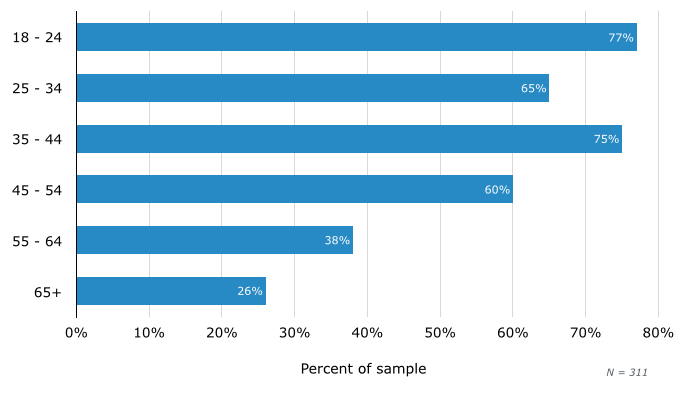
Our survey defined seeking customer support as “seeking an answer to a question about a product or service.” We also made it clear we were asking about respondents’ use of non-voice service channels, such as online searches and mobile apps—not about making phone calls with mobile devices.
The number of millennials (ages 18-35) using mobile devices to seek customer support is indeed very high. But a more significant takeaway for businesses is the high percentage of consumers of all ages doing the same.
In fact, when weighing our results to be representative of the age distribution of the U.S. adult population, we find that a combined 63 percent seek customer service with a mobile device several times a month or more.
U.S. Population: Frequency of Seeking Customer Support on Mobile
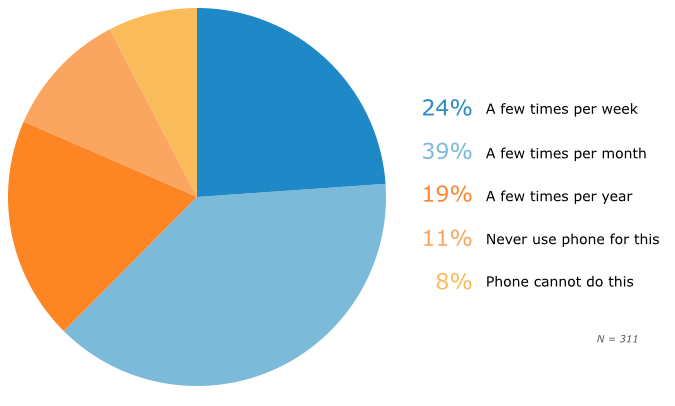
This finding should serve as a wake-up call to companies that still prioritize more traditional service channels, such as phone and email, over online support that’s easily accessible via mobile.
Key Takeaway: Engage Customers Through Multiple Mobile Channels
To really succeed with mobile consumers, businesses sometimes need to get creative. Mobile devices are, after all, more than just hand-held Web browsers. People use mobile devices for a very wide range of activities, including text messages, social media, taking/viewing photos and GPS navigation.
SMS, or mobile text messaging, is one popular activity, in both business and social contexts, research by Heywire, an SMS platform for businesses, found that 67 percent of business professionals have used SMS for business communications.
“[Many companies are] conducting important sales and support conversations with customers, but it’s all off the record and unsecured,” explains Heywire CEO Meredith Flynn-Ripley. “Text-message software allows companies to use SMS as a secure and official service channel.”
Twitter is another channel that companies can use to engage customers. Sandro Galindo is the CEO of Shoreway Media, an agency that helps companies attract mobile and social media consumers. He explains how the company engages its clients’ on-the-go customers using tweets:
For example, “We have had people tweet [clients of ours that have] a restaurant, with a simple: ‘Hey @[restaurant name], do you have room for five people at 7:30 tonight?’” he says.
“Instead of calling or going to a site like OpenTable, they tweet. We respond with a ‘yes,’ and then get the information we need to make the reservation.”
While these strategies may not work for every business model, they illustrate how businesses can become more mobile-friendly.
After all, engagement through text messages and Twitter are examples of meeting customers where they are already spending their time—and that provides a large head start in terms of a positive CX.
42 Percent Have Used Live Chat on Mobile Devices
Technology “early adopter” status is another common variable that can reveal patterns in consumer preferences and habits. An early adopter is a person who tends to purchase new technology products as soon as they hit the market.
Since they’re known to seek out new technology and new uses for technology, early adopters are also often among the first to try new service channels, including video calling and live chat customer support.
Our survey asked respondents how often they are first among their friends and family to purchase new technology products. We correlated this information with responses to a separate question about their use of live chat on mobile devices.
While live chat is an extremely effective and increasingly popular channel for online customer service, more consumers use live chat from desktop or laptop computers than from mobile devices.
A surprisingly high portion of our respondents report having used live chat on mobile devices. There is a correlation between early-adopter status, though it’s not perfectly linear.
Use of Live Chat on a Mobile Device, by Tech-Adopter Status
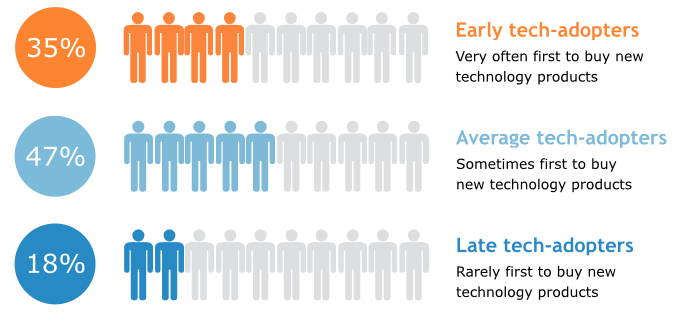
Here, as with the age-based results above, it’s important that businesses don’t miss the big picture by focusing too much on the details.
While parsing customer habits and preferences by age, early-adopter status or other variables can help businesses target those specific customers, the overall message is more compelling: Consumers, regardless of how we segment them, are using mobile devices to seek customer support in significant numbers and through a variety of mobile channels.
Key Takeaway: Adopt a ‘Mobile First’ Strategy
Since so many customers are seeking support on mobile, what can companies do to reach them and provide a high-quality CX? Several of the businesses we spoke to suggest that new businesses, or those creating new websites, should adopt a “mobile first” strategy.
A mobile-first strategy means that no matter what a customer might need to do—learn about a new product, receive customer support, process a return or chat with an employee—it can be done on a mobile device and the CX will be equally positive.
This strategy can distinguish companies from those for which mobile support is an afterthought.
Brian Dear, founder and CEO of telehealth platform iCouch, explains how his company has embraced a mobile-first approach for both customers and employees:
“We assume all users are mobile in terms of designing our support articles as well as our support portal. In terms of keeping up with support requests, we leverage mobile apps that alert us instantly to incoming support requests, and thus, allow us to help any customer anywhere we happen to be.”
Brian Dear, iCouch
But when consumers seek service on mobile devices, what kind of CX are they getting?
Nearly All Consumers Have Had Poor CX Using Mobile Company Websites
Many websites were designed to display on the large screens of desktop and laptop computers. If a customer tries to view a site that has not been optimized for mobile on the smaller screen of say, a smartphone, the results can be poor. Pictures and text may appear tiny, page elements can scale incorrectly and overlap and navigation buttons can be hard to find and click.
These issues all detract from a mobile customer’s CX—and often prevent the customer from finding the information they seek.
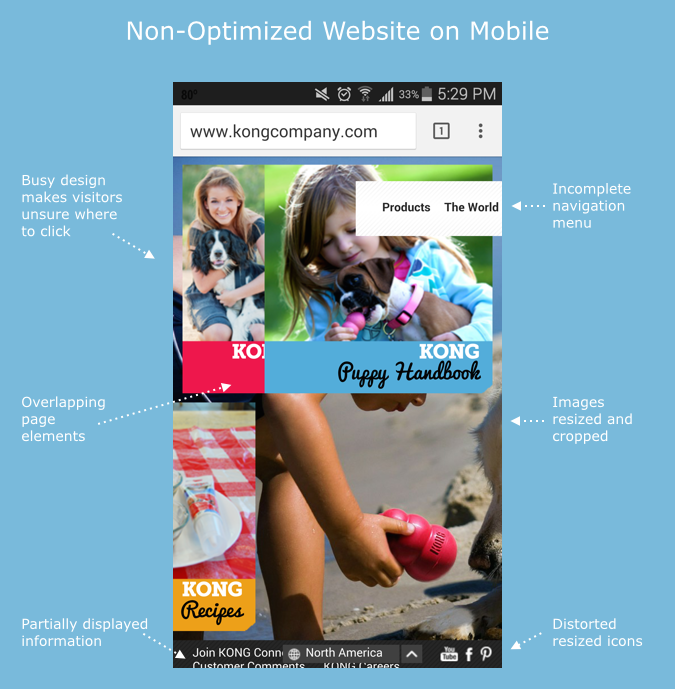
Most of our survey respondents have experienced these problems. Topping the list are problems with pages displaying and loading incorrectly, leading to and including difficulty navigating the page, cited by 90 percent.
CX Issues Encountered When Seeking Information on Mobile Websites
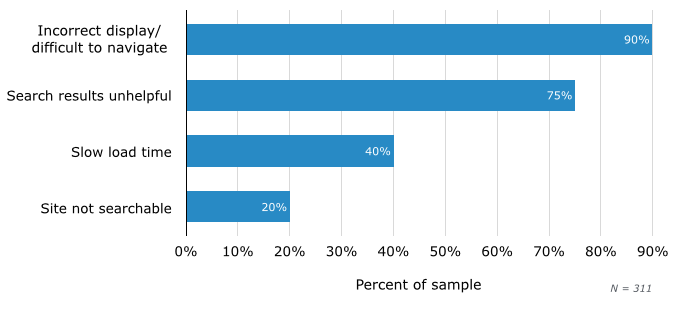
The second most common issue is not being able to find relevant and useful search results within the company’s website. This includes searches that returned too many results, results not related to the search and results that lacked useful information.
While these problems aren’t specific to mobile devices—the same results would appear if browsing from a desktop—it can be especially frustrating to sort through long lists of search results on a small mobile screen.
So, what can companies do to prevent poor CX on mobile devices?
Key Takeaway: Make Your Company Website Mobile-Friendly
Online gift retailer IThoughtofYou.com is another company that is experiencing success reaching customers on mobile, as founder Mandy Nagel explains.
“We have fully embraced mobile support in every facet. Our website was built responsively from the start to engage our mobile purchase points,” she says.
Nagel is referring here to responsive design, a Web development method for creating websites that “respond” differently based on what device a person uses to view them. The site content rearranges and resizes automatically so that it fits well, looks good and is navigable on desktops, laptops, smartphones and tablets alike.
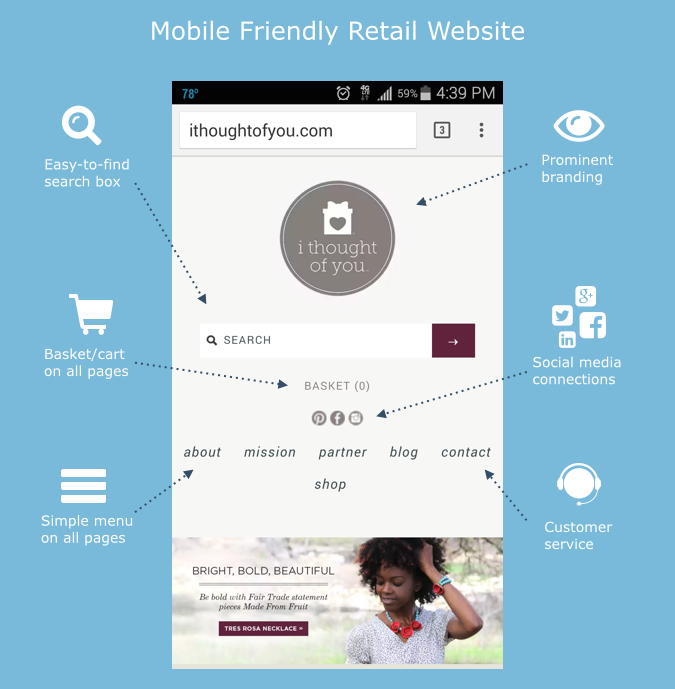
“The website analytics for our company show a growing percentage of customers interacting with us on their smartphones and other mobile devices,” Nagel continues. “This continues to drive home the point [of] how important it is to make your brand mobile-friendly.”
Nagel is pointing out a shift in the way businesses think about mobile. Five years ago, a company was ahead of the curve if it simply had a mobile-friendly website (i.e., one that displayed correctly on mobile devices).
Today, companies want their entire brand to be mobile-friendly: This means that every interaction a customer could have with a brand can be had equally well on mobile.
The first step towards achieving this goal is ensuring that a company’s website provides a good CX to mobile users. Companies that outsource their Web development should ensure that mobile compatibility is a priority. This can include taking steps to make a site entirely responsive, or to simply create a mobile-optimized version of the site.
For small and midsized businesses (SMBs) or others that do their Web design in-house, website-building software, such as Webflow and CoffeeCup’s Responsive Layout Maker Pro, can help ensure a mobile-friendly finished product without requiring much technical expertise.
Key Takeaway: Use Self-Service Information Management
The second most common problem encountered by mobile customers seeking support information is that the results returned from searching company websites are not helpful.
These searches can often return hundreds of suggested support articles—and sifting through to find the one that addresses their question can be a very tedious task, especially when using a small screen.
This is the type of poor CX that can frustrate customers, forcing them to call the company, write an email or, in the worst-case scenario, take their business elsewhere.
Many companies address this problem by using virtual agent software, offered by vendors such as IntelliResponse and InteliWISE. This software is, essentially, a much more sophisticated search engine for company resources. It uses natural language processing and follow-up questions to hone in on the customer’s exact question and present the best possible answer.
A second approach to improving search results comes with improvements in knowledge management. If a company can better organize its library of support documents, it can present much more relevant results to information-seekers.
While knowledge management is a category of software all its own, many CRM platforms also include these capabilities: SugarCRM, Desk.com and Zendesk are three examples.
Finally, adopting a “level zero solvable” (LZS) approach to support-article management can help companies figure out exactly which articles are most likely to help customers. Removing those that don’t help can be a great benefit to customers facing too many search results. (More information about what LZS is, how it works and what its benefits are can be found here.)
Mobile Apps Can Help Solve Existing Business Challenges
A mobile app is a software application that runs on a mobile device. Many companies offer their own mobile apps, but the popularity of these apps with consumers is very hit or miss.
Banks, for example, have had success with mobile apps because they provide a simple, secure way to check balances, make transfers and seek support. In fact, some experts say that using a bank’s mobile app to conduct online banking is actually more to access the bank’s website.
Other types of companies (retailers, for example) have more difficult choices to make, because all too often, their apps don’t offer anything to customers that a well-designed website wouldn’t: Unless an app can offer something of added value, it’s unlikely to become popular on its own.
This sometimes results in a counterproductive scenario, where a company has a website that provides a great mobile CX, but it also has an app that few use—so it sacrifices the website’s CX by using it to push the app on customers.
Dave Giannetto is a consultant who advises businesses on leveraging new technologies. We spoke to him on the topic of his new book, “Big Social Mobile: How Digital Initiatives Can Reshape the Enterprise and Drive Business Results,” and on the confusion many business operators feel as they consider mobile customer service, mobile apps and mobile CX.
“A lot of experts are saying to businesses: ‘You need to be highly social; you need to be highly mobile; you need to be collecting massive amounts of big data.’ I’m saying, no, no, no. That’s a recipe for disaster. It’s an approach that leads to failure a majority of the time,” Giannetto explains.
Instead, he says, businesses should look to augment their existing competitive advantage or value proposition in a way these new technologies allow. They should also look for ways to use new technologies to solve long-standing challenges, but they should begin by identifying the challenges.
The disaster Giannetto is referring to occurs when companies adopt new technology simply because it’s new, and then expect it to deliver results.
He gives the example of the Starbucks mobile app, now the most successful mobile payment system in the country, as an example of how a mobile strategy should proceed:
Starbucks did not begin with the goal of creating a new mobile app. Instead, it began by recognizing a challenge: the fact that cash register operations were the largest bottleneck in its busy stores.
When looking for solutions to this challenge, it realized that a mobile app could speed up the process. So the company created an app that helps customers pay for purchases and track and redeem rewards points, removing the need to count change for every transaction or rely on designated rewards cards.
The resulting mobile app has increased the efficiency of Starbucks stores, allowing the company to serve more customers. It also saves customers time, both in line and once they get to the register.

The Starbucks mobile app, with a barcode that lets customers redeem reward points
The last function of the Starbucks app—saving customers time—is the key component of its success. Mobile apps that can offer benefits directly to consumers that they will seek out voluntarily (in this case, credit for free food and beverages) will have a better chance of widespread adoption.
Though most of Giannetto’s clients are large enterprises, he notes that SMBs can use similar strategies.
The most important thing, he says, is to:
“Stay centered on what has made your business valuable to consumers, what works about you, what they like and love about you—and then amplify that and use it in ways that are supported by these new mobile technologies.”
Dave Giannetto, Consultant
Conclusions
Many SMBs are understandably overwhelmed at the prospect of catering to customers on a new platform. Many others are wondering if it’s really necessary, if it will help the business or if customers will even use it.
However, in the case of mobile customer service, the data is clear: Customers of all ages and degrees of technological literacy are looking for support via mobile devices, and virtually all of them have experienced a variety of CX-degrading issues while doing so.
If you have comments or would like to obtain access to any of the charts above, please contact craig@softwareadvice.com.
Methodology
To collect the data for this report, we conducted an online survey of 12 questions of U.S. adults. Software Advice performed and funded this research independently.
Results are representative of our survey sample, not necessarily the population as a whole. Sources attributed and products referenced in this article may or may not represent client vendors of Software Advice, but vendor status is never used as a basis for selection. Chart values are rounded to the nearest whole number.